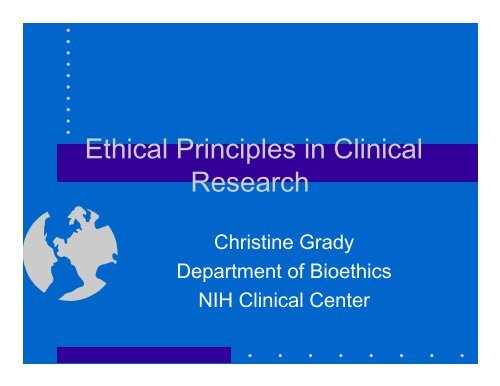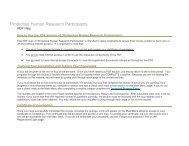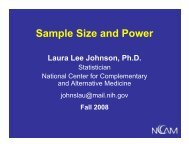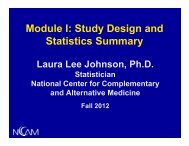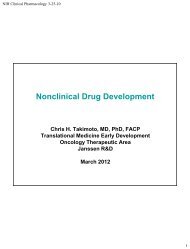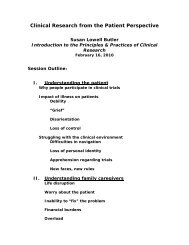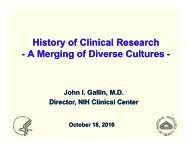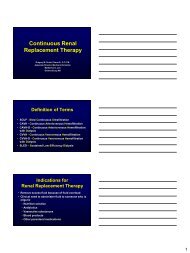Ethical Principles in Clinical Research
Ethical Principles in Clinical Research
Ethical Principles in Clinical Research
You also want an ePaper? Increase the reach of your titles
YUMPU automatically turns print PDFs into web optimized ePapers that Google loves.
<strong>Ethical</strong> <strong>Pr<strong>in</strong>ciples</strong> <strong>in</strong> Cl<strong>in</strong>ical<br />
<strong>Research</strong><br />
Christ<strong>in</strong>e Grady<br />
Department of Bioethics<br />
NIH Cl<strong>in</strong>ical Center
• Dr. Progress proposes a placebo controlled<br />
study of a new promis<strong>in</strong>g drug <strong>in</strong> children<br />
and adults with a serious disease.<br />
• How do we know whether or not the<br />
proposed study is ethical
Moral problem <strong>in</strong> cl<strong>in</strong>ical research<br />
• The goal of cl<strong>in</strong>ical research is to generate<br />
useful knowledge about human health and<br />
illness, and ways to prevent, diagnose and<br />
treat diseases.<br />
• The goal is not benefit to the <strong>in</strong>dividuals who<br />
participate (although there is sometimes benefit)<br />
• People are the means to develop<strong>in</strong>g useful<br />
knowledge; and are thus at risk of exploitation
Ethics of Cl<strong>in</strong>ical <strong>Research</strong><br />
• <strong>Ethical</strong> requirements <strong>in</strong> cl<strong>in</strong>ical research<br />
aim to:<br />
– m<strong>in</strong>imize the possibility of exploitation;<br />
– ensure that the rights and welfare of subjects<br />
are respected while they contribute to the<br />
generation of knowledge.
Codes and Guidel<strong>in</strong>es<br />
• Nuremberg Code (1949)<br />
• Declaration Of Hels<strong>in</strong>ki (1964- 2000, 2008)<br />
• The Belmont Report (1979)<br />
• CIOMS/WHO International Guidel<strong>in</strong>es (1993, 2002)<br />
• ICH/GCP-International Conference on<br />
Harmonization- Good Cl<strong>in</strong>ical Practice
THE BELMONT REPORT<br />
• <strong>Ethical</strong> pr<strong>in</strong>ciples underly<strong>in</strong>g the<br />
conduct of research:<br />
– Respect for persons<br />
– Beneficence<br />
–Justice
Dist<strong>in</strong>ction between cl<strong>in</strong>ical research<br />
and cl<strong>in</strong>ical practice<br />
• Goals<br />
• Methods<br />
• Risks<br />
– The Belmont Report
U.S. Regulations and Guidel<strong>in</strong>es<br />
• The Common Rule (US 45CFR.46)<br />
• FDA regulations (US 21CFR50 and 56, and<br />
others)<br />
• NIH policy and guidel<strong>in</strong>es
45CFR.46 Protection of Human<br />
Subjects<br />
• Composition and function of a local<br />
<strong>in</strong>stitutional review board (IRB)<br />
• Criteria for IRB approval of proposals<br />
• Requirements regard<strong>in</strong>g <strong>in</strong>formed<br />
consent
45CFR 46<br />
• Subpart B- Fetuses, pregnant women,<br />
and human <strong>in</strong> vitro fertilization<br />
• Subpart C- Prisoners as subjects<br />
• Subpart D- Children
FDA REGULATIONS<br />
• 21CFR.50 Protection of Human<br />
Subjects (<strong>in</strong>formed consent)<br />
– Subpart D on research with children<br />
• 21CFR.56 IRB composition and function
Exist<strong>in</strong>g guidance<br />
• Most developed <strong>in</strong> response to specific<br />
problems<br />
• Some issues <strong>in</strong>completely addressed,<br />
<strong>in</strong>clude divergent recommendations<br />
• Need for a systematic, coherent, universally<br />
applicable framework
<strong>Ethical</strong> framework: 7 pr<strong>in</strong>ciples<br />
• Valuable scientific question<br />
• Valid scientific methodology<br />
• Fair subject selection<br />
• Favorable risk-benefit evaluation<br />
• Independent review<br />
• Informed consent<br />
• Respect for enrolled subjects<br />
Emanuel E, Wendler D, Grady C. What makes cl<strong>in</strong>ical research ethical Journal of the<br />
American Medical Association 2000; 283(20):2701-11
Valuable Scientific Question<br />
<strong>Ethical</strong> cl<strong>in</strong>ical research should answer<br />
a valuable question, i.e., one that will<br />
generate new knowledge or<br />
understand<strong>in</strong>g about human health or<br />
illness, i.e. a socially, cl<strong>in</strong>ically, or<br />
scientifically useful question
Valid Scientific Methodology<br />
• <strong>Ethical</strong> cl<strong>in</strong>ical research should be<br />
designed <strong>in</strong> a methodologically rigorous<br />
manner (design, methods, statistical<br />
power and methods, etc.) that will yield<br />
valid, reliable, generalizable, and<br />
<strong>in</strong>terpretable data, and that is feasible
Fair subject selection<br />
• Scientific objectives should guide <strong>in</strong>clusion<br />
criteria, recruitment strategies, and selection<br />
(not privilege or easy availability or<br />
vulnerability)<br />
• Fairly distribute harms and benefits<br />
• No exclusion without justification
<strong>Research</strong> as burden or benefit<br />
<strong>Research</strong> as<br />
‘burden’<br />
Subjects need<br />
protection<br />
<strong>Research</strong> as<br />
‘benefit’<br />
Subjects<br />
need access
Favorable risk-benefit<br />
• Are risks to subjects necessary and<br />
m<strong>in</strong>imized<br />
• Are risks justified by benefit to <strong>in</strong>dividual<br />
subjects and/or the importance of the<br />
knowledge to society<br />
• Are benefits maximized
Risks <strong>in</strong> research<br />
• Def<strong>in</strong><strong>in</strong>g risks<br />
– Probability and magnitude<br />
– Types of risk<br />
– Uncerta<strong>in</strong>ty<br />
• M<strong>in</strong>imiz<strong>in</strong>g risks<br />
• Limit<strong>in</strong>g risk
Benefits <strong>in</strong> research<br />
• Def<strong>in</strong><strong>in</strong>g benefits<br />
– Direct versus secondary benefits<br />
• Maximiz<strong>in</strong>g benefits<br />
• Balanc<strong>in</strong>g risks and benefits
Benefits and Risks <strong>in</strong> <strong>Research</strong><br />
[I]nterests other than those of the subject<br />
may on some occasions be sufficient by<br />
themselves to justify the risks <strong>in</strong>volved <strong>in</strong><br />
the research, so long as the subjects’ rights<br />
have been protected.<br />
The Belmont Report
Independent review<br />
• To ensure ethical requirements have been<br />
fulfilled<br />
• To check <strong>in</strong>vestigator biases and conflicts<br />
• To assure the public that research is not<br />
exploit<strong>in</strong>g <strong>in</strong>dividuals or groups
Criteria for IRB Review<br />
(45CFR.46.111 and 21CFR56.111)<br />
• Risks … are m<strong>in</strong>imized.<br />
• Risks are justified by anticipated benefits, if<br />
any, to the subjects or the importance of the<br />
knowledge to be ga<strong>in</strong>ed<br />
• Subjects will be selected and treated fairly<br />
• Informed consent is adequate
Informed Consent<br />
• Informed consent ensures that<br />
<strong>in</strong>dividuals have the opportunity to<br />
decide whether they want to participate<br />
<strong>in</strong> research or cont<strong>in</strong>ue participation and<br />
whether it is compatible with their goals,<br />
values and <strong>in</strong>terests
Informed Consent<br />
• The voluntary consent of the human<br />
subject is absolutely essential.<br />
Nuremberg Code<br />
• For all biomedical research <strong>in</strong>volv<strong>in</strong>g<br />
human subjects, the <strong>in</strong>vestigator must<br />
obta<strong>in</strong> the <strong>in</strong>formed consent of the<br />
prospective subject…or authorized<br />
representative. CIOMS guidel<strong>in</strong>es
Informed Consent<br />
• “To the degree subjects are capable,<br />
they should be given the opportunity to<br />
choose what shall or shall not happen to<br />
them”. The Belmont Report<br />
• Extra protections for those with limited<br />
capacity to consent
Informed consent<br />
• Disclosure of <strong>in</strong>formation<br />
• Understand<strong>in</strong>g<br />
• Voluntary decision mak<strong>in</strong>g<br />
• Authorization
Informed Consent<br />
Federal regulations require the follow<strong>in</strong>g <strong>in</strong>formation <strong>in</strong> the<br />
consent form<br />
1) That it is research, the purpose, duration, and<br />
nature of the procedures<br />
2) Risks<br />
3) Benefits<br />
4) Alternatives<br />
5) Confidentiality of records<br />
6) Compensation for <strong>in</strong>juries<br />
7) Person to contact for answers to questions<br />
8) Voluntar<strong>in</strong>ess and right to withdraw
IRB review<br />
Does the plan for <strong>in</strong>form<strong>in</strong>g participants<br />
about the objectives, risks, benefits,<br />
and alternatives of the study, assess<strong>in</strong>g<br />
understand<strong>in</strong>g, and seek<strong>in</strong>g their<br />
voluntary agreement seem adequate
Respect for enrolled subjects<br />
• <strong>Ethical</strong> research requires cont<strong>in</strong>ued respect for the<br />
rights and welfare of participants throughout<br />
research, <strong>in</strong>clud<strong>in</strong>g:<br />
– Protect<strong>in</strong>g confidentiality<br />
– Monitor<strong>in</strong>g welfare<br />
– Recogniz<strong>in</strong>g right to withdraw<br />
– Provid<strong>in</strong>g new <strong>in</strong>formation<br />
– Inform<strong>in</strong>g participants of f<strong>in</strong>d<strong>in</strong>gs<br />
– Post trial plann<strong>in</strong>g
Respect for enrolled subjects<br />
• Dur<strong>in</strong>g the course of the experiment the<br />
human subject should be at liberty to br<strong>in</strong>g<br />
the experiment to an end… Nuremberg Code<br />
• …Every precaution should be taken to<br />
respect the privacy of the subject ,the<br />
confidentiality of the subject’s <strong>in</strong>formation,<br />
and to m<strong>in</strong>imize the impact of the study on …<br />
physical and mental <strong>in</strong>tegrity and on the<br />
personality of the subject. Hels<strong>in</strong>ki 2000
7 pr<strong>in</strong>ciples<br />
• Valuable scientific question<br />
• Valid scientific methodology<br />
• Fair subject selection<br />
• Favorable risk-benefit evaluation<br />
• Independent review<br />
• Informed consent<br />
• Respect for enrolled subjects
Framework<br />
• Systematic and sequential<br />
• Necessary<br />
– Procedural requirements may be waived<br />
• Universal<br />
– Adapted and implemented accord<strong>in</strong>g to context<br />
• Require balanc<strong>in</strong>g, specify<strong>in</strong>g
Balanc<strong>in</strong>g pr<strong>in</strong>ciples<br />
• Example: Randomized Controlled Trials<br />
• Balanc<strong>in</strong>g the need for a rigorous design<br />
with the obligation to maximize benefits<br />
and m<strong>in</strong>imize harms
• When can a placebo control be used<br />
–Cold<br />
– Hypertension<br />
– Depression<br />
– Cancer
Case<br />
• In a cl<strong>in</strong>ical trial test<strong>in</strong>g the safety and efficacy<br />
of a novel <strong>in</strong>tervention that has promise as an<br />
important treatment- is it more ethical to enroll<br />
mildly-moderately ill young adults or severely<br />
ill children
• Stress <strong>in</strong>formed consent<br />
– Adults should be enrolled because they can<br />
consent. As long as able to answer the scientific<br />
question, not necessary to enroll patients who<br />
cannot consent.
• Stress risk-benefit and social value<br />
– Informed consent is not an absolute requirement. The<br />
<strong>in</strong>fants are at least as well off <strong>in</strong> the trial as <strong>in</strong> cl<strong>in</strong>ical<br />
care and will be contribut<strong>in</strong>g to scientific knowledge.<br />
F<strong>in</strong>d<strong>in</strong>g an effective treatment is more important for<br />
those with severe disease. The risk/benefit assessment<br />
is also more favorable s<strong>in</strong>ce the severely ill <strong>in</strong>fants have<br />
more to ga<strong>in</strong> from successful treatment and less to lose<br />
if they suffer side effects than do the mildly ill young<br />
adults
• Cannot enroll ill <strong>in</strong>fants s<strong>in</strong>ce they are<br />
vulnerable<br />
• Stay tuned…
L<strong>in</strong>ks to more <strong>in</strong>formation<br />
• http://www.wma.net<br />
• http://www.cioms.ch<br />
• http://ohrp.osophs.dhhs.gov<br />
• http://ohsr.od.nih.gov<br />
• http://www/fda.gov<br />
• http://grants.nih.gov/grants/policy/hs/<strong>in</strong>dex.htm<br />
• http://cme.nci.nih.gov


